Assessment of Hydrological Extremes for Arid Catchments: A Case Study in Wadi Al Jizzi, North-West Oman
Abstract
1. Introduction
- A series of basaltic mountains surrounding the catchment from the western part, known as Al Hajar Al Gharbi.
- Hyper arid catchment characteristics, including a limited number of high-intensity, annual storm rainfall events in a short time.
- The catchment is dominated by bare soil and very limited vegetation cover.
2. Study Area
- To recharge the ground water which has a water table level of 172 m underground, and
- To protect Sohar City from flash floods during wet seasons.
3. Methodology
3.1. Rainfall and Runoff Data
3.2. Standard Precipitation Index (SPI)
3.3. Rainfall Anomaly Index (RAI)
- N = Current monthly/yearly rainfall (mm),
- = Monthly/yearly average rainfall of the historical series (mm),
- = Average of the ten highest monthly/yearly precipitations of the historical series (mm), and
- = Average of the ten lowest monthly/yearly precipitations of the historical series (mm).
3.4. Soil Conservation Service-Curve Number (SCS-CN) Method
- Q = Runoff depth (mm),
- P = Rainfall (mm),
- Ia = Initial abstraction (mm),
- S = Maximum retention after runoff begins (mm × 25.4 to convert from inches),
- CN = Curve number, and
- = Simulated runoff using SCS method (m3/s),
- = Observed runoff records (m3/s), and
- = Average observed runoff (m3/s).
4. Results and Discussion
4.1. Drought Indices Analysis
4.2. Rainfall-Runoff Modelling
Soil Conservation Service-Curve Number (SCS-CN) Method
- Rainfall intensity and storm duration.
- Soil type and retention time.
- Temperature and other weather parameters.
- The soil moisture content is at welting point (soil profile is practically dry).
- Below saturation level: average condition occurred by some short rainfall storms but not long enough to create a runoff.
- The soil profile is practically saturated or super saturated from antecedent rainfall storms.
5. Conclusions
Author Contributions
Funding
Institutional Review Board Statement
Informed Consent Statement
Acknowledgments
Conflicts of Interest
References
- El Kenawy, A.M.; Al Buloshi, A.; Al-Awadhi, T.; Al Nasiri, N.; Navarro-Serrano, F.; Alhatrushi, S.; Robaa, S.M.; Domínguez-Castro, F.; McCabe, M.F.; Schuwerack, P.-M.; et al. Evidence for intensification of meteorological droughts in Oman over the past four decades. Atmos. Res. 2020, 246, 105126. [Google Scholar] [CrossRef]
- Szalai, S.; Szinell, C.S. Comparison of two drought indices for drought monitoring in Hungary—A case study. In Drought and Drought Mitigation in Europe; Springer: Berlin/Heidelberg, Germany, 2000; pp. 161–166. [Google Scholar]
- Conway, D. Extreme Hydrological Events: Precipitation, Floods and Droughts. J. Arid Environ. 1995, 29, 124–125. [Google Scholar] [CrossRef]
- Dutta, R.; Maity, R. Time-varying network-based approach for capturing hydrological extremes under climate change with application on drought. J. Hydrol. 2021, 603, 126958. [Google Scholar] [CrossRef]
- Kourgialas, N.N. Hydroclimatic impact on mediterranean tree crops area–Mapping hydrological extremes (drought/flood) prone parcels. J. Hydrol. 2021, 596, 125684. [Google Scholar] [CrossRef]
- Adikari, K.E.; Shrestha, S.; Ratnayake, D.T.; Budhathoki, A.; Mohanasundaram, S.; Dailey, M.N. Evaluation of artificial intelligence models for flood and drought forecasting in arid and tropical regions. Environ. Model. Softw. 2021, 144, 105136. [Google Scholar] [CrossRef]
- McKee, T.B.; Doesken, N.J.; Kleist, J. The relationship of drought frequency and duration to time scales. In Proceedings of the Proceedings of the 8th Conference on Applied Climatology, Anaheim, CA, USA, 17–22 January 1993; pp. 179–183. [Google Scholar]
- Ali, M.; Deo, R.C.; Maraseni, T.; Downs, N.J. Improving SPI-derived drought forecasts incorporating synoptic-scale climate indices in multi-phase multivariate empirical mode decomposition model hybridized with simulated annealing and kernel ridge regression algorithms. J. Hydrol. 2019, 576, 164–184. [Google Scholar] [CrossRef]
- Zhao, W.; Yan, T.; Peng, S.; Ding, M.; Lai, X. Drought and flood characteristics evolution in peninsular region of Shandong Province based on standardized precipitation index. In IOP Conference Series: Earth and Environmental Science; IOP Publishing: Bristol, UK, 2020; Volume 601, p. 12021. [Google Scholar]
- Tsesmelis, D.E.; Vasilakou, C.G.; Kalogeropoulos, K.; Stathopoulos, N.; Alexandris, S.G.; Zervas, E.; Oikonomou, P.D.; Karavitis, C.A. Chapter 46—Drought assessment using the standardized precipitation index (SPI) in GIS environment in Greece. In Computers in Earth and Environmental Sciences; Pourghasemi, E.S., Ed.; Elsevier: Amsterdam, The Netherlands, 2022; pp. 619–633. ISBN 978-0-323-89861-4. [Google Scholar]
- Łabędzki, L. Estimation of local drought frequency in central Poland using the standardized precipitation index SPI. Irrig. Drain. J. Int. Comm. Irrig. Drain. 2007, 56, 67–77. [Google Scholar] [CrossRef]
- Zhai, J.; Su, B.; Krysanova, V.; Vetter, T.; Gao, C.; Jiang, T. Spatial variation and trends in PDSI and SPI indices and their relation to streamflow in 10 large regions of China. J. Clim. 2010, 23, 649–663. [Google Scholar] [CrossRef]
- Tufaner, F.; Özbeyaz, A. Estimation and easy calculation of the Palmer Drought Severity Index from the meteorological data by using the advanced machine learning algorithms. Environ. Monit. Assess. 2020, 192, 1–14. [Google Scholar] [CrossRef]
- Abushandi, E.; Merkel, B. Rainfall estimation over the Wadi Dhuliel arid catchment, Jordan from GSMaP_MVK+. Hydrol. Earth Syst. Sci. Discuss. 2011, 8, 1665–1704. [Google Scholar]
- Abushandi, E. Flash flood simulation for Tabuk City catchment, Saudi Arabia. Arab. J. Geosci. 2016, 9, 1–10. [Google Scholar] [CrossRef]
- Shadeed, S.; Almasri, M. Application of GIS-based SCS-CN method in West Bank catchments, Palestine. Water Sci. Eng. 2010, 3, 1–13. [Google Scholar]
- Alzghoul, M.; Al-husban, Y. Estimation of Runoff by applying SCS Curve Number Method, in a complex arid area; Wadi Al-Mujib watershed; Study case. Dirasat Hum. Soc. Sci. 2021, 48. Available online: https://archives.ju.edu.jo/index.php/hum/article/view/104919 (accessed on 22 May 2022).
- El-Hames, A.S. An empirical method for peak discharge prediction in ungauged arid and semi-arid region catchments based on morphological parameters and SCS curve number. J. Hydrol. 2012, 456, 94–100. [Google Scholar] [CrossRef]
- Al-Ghobari, H.; Dewidar, A.; Alataway, A. Estimation of Surface Water Runoff for a Semi-Arid Area Using RS and GIS-Based SCS-CN Method. Water 2020, 12, 1924. [Google Scholar] [CrossRef]
- Braud, I.; Borga, M.; Gourley, J.; Hurlimann, M.; Zappa, M.; Gallart, F. Flash floods, hydro-geomorphic response and risk management. J. Hydrol. 2016, 541, 1–5. [Google Scholar] [CrossRef]
- Karagiorgos, K.; Thaler, T.; Heiser, M.; Hübl, J.; Fuchs, S. Integrated flash flood vulnerability assessment: Insights from East Attica, Greece. J. Hydrol. 2016, 541, 553–562. [Google Scholar] [CrossRef]
- Mahmood, M.I.; Elagib, N.A.; Horn, F.; Saad, S.A.G. Lessons learned from Khartoum flash flood impacts: An integrated assessment. Sci. Total Environ. 2017, 601–602, 1031–1045. [Google Scholar] [CrossRef]
- Abushandi, E.; Al Sarihi, M. Flash flood inundation assessment for an arid catchment, case study at Wadi Al Jizzi, Oman. Water Pract. Technol. 2022, 17, 1155–1168. [Google Scholar] [CrossRef]
- Al Ruheili, A.; Dahm, R.; Radke, J. Wadi flood impact assessment of the 2002 cyclonic storm in Dhofar, Oman under present and future sea level conditions. J. Arid Environ. 2019, 165, 73–80. [Google Scholar] [CrossRef]
- Niyazi, B.A.; Masoud, M.H.; Ahmed, M.; Basahi, J.M.; Rashed, M.A. Runoff assessment and modeling in arid regions by integration of watershed and hydrologic models with GIS techniques. J. Afr. Earth Sci. 2020, 172, 103966. [Google Scholar] [CrossRef]
- Saber, M.; Hamaguchi, T.; Kojiri, T.; Tanaka, K.; Sumi, T. A physically based distributed hydrological model of wadi system to simulate flash floods in arid regions. Arab. J. Geosci. 2015, 8, 143–160. [Google Scholar] [CrossRef]
- El Alfy, M. Assessing the impact of arid area urbanization on flash floods using GIS, remote sensing, and HEC-HMS rainfall–runoff modeling. Hydrol. Res. 2016, 47, 1142–1160. [Google Scholar] [CrossRef]
- Jodar-Abellan, A.; Valdes-Abellan, J.; Pla, C.; Gomariz-Castillo, F. Impact of land use changes on flash flood prediction using a sub-daily SWAT model in five Mediterranean ungauged watersheds (SE Spain). Sci. Total Environ. 2019, 657, 1578–1591. [Google Scholar] [CrossRef] [PubMed]
- Aghabeigi, N.; Esmali, O.A.; Mostafazadeh, R.; Golshan, M. The Effects of Climate Change on Runoff Using IHACRES Hydrologic Model in Some of Watersheds, Ardabil Province. Irrig. Water Eng. 2020, 10, 178–189. [Google Scholar]
- Abushandi, E.; Merkel, B. Modelling rainfall runoff relations using HEC-HMS and IHACRES for a single rain event in an arid region of Jordan. Water Resour. Manag. 2013, 27, 2391–2409. [Google Scholar] [CrossRef]
- Siebert, S.; Nagieb, M.; Buerkert, A. Climate and irrigation water use of a mountain oasis in northern Oman. Agric. Water Manag. 2007, 89, 1–14. [Google Scholar] [CrossRef]
- Searle, M.P. Preserving Oman’s geological heritage: Proposal for establishment of World Heritage Sites, National GeoParks and Sites of Special Scientific Interest (SSSI). Geol. Soc. London, Spec. Publ. 2014, 392, 9–44. [Google Scholar] [CrossRef]
- Al-Kindi, R.S. Assessment of Groundwater Recharge from the Dam of Wadi Al-Jizzi, Sultanate of Oman; United Arab Emirates University: Al Ain, United Arab Emirates, 2014. [Google Scholar]
- Al Maqbali, N. Risk Assessment of Dams; University of Adelaide: Adelaide, Australia, 1999. [Google Scholar]
- Abushandi, E. Flood Water Management in Arid Regions, Case Studies: Wadi Al Jizzi, Oman, Wadi Abu Nsheifah, Saudi Arabia, and Wadi Dhuleil, Jordan. In Recent Advances in Environmental Science from the Euro-Mediterranean and Surrounding Regions; Kallel, A., Ksibi, M., Ben Dhia, H., Khélifi, N., Eds.; Springer International Publishing: Cham, Switzerland, 2018; pp. 1813–1814. [Google Scholar]
- Costa, J.A.; Rodrigues, G.P. Space-time distribution of rainfall anomaly index (RAI) for the Salgado Basin, Ceará State-Brazil. Ciência e Nat. 2017, 39, 627–634. [Google Scholar] [CrossRef]
- Zhao, H.; Gao, G.; An, W.; Zou, X.; Li, H.; Hou, M. Timescale differences between SC-PDSI and SPEI for drought monitoring in China. Phys. Chem. Earth Parts A/B/C 2017, 102, 48–58. [Google Scholar] [CrossRef]
- Wang, S.; Najafi, M.R.; Cannon, A.J.; Khan, A.A. Uncertainties in Riverine and Coastal Flood Impacts under Climate Change. Water 2021, 13, 1774. [Google Scholar] [CrossRef]
- Verma, S.; Singh, P.K.; Mishra, S.K.; Singh, V.P.; Singh, V.; Singh, A. Activation soil moisture accounting (ASMA) for runoff estimation using soil conservation service curve number (SCS-CN) method. J. Hydrol. 2020, 589, 125114. [Google Scholar] [CrossRef]
- Liu, J.; Yuan, D.; Zhang, L.; Zou, X.; Song, X. Comparison of Three Statistical Downscaling Methods and Ensemble Downscaling Method Based on Bayesian Model Averaging in Upper Hanjiang River Basin, China. Adv. Meteorol. 2016, 2016, 7463963. [Google Scholar] [CrossRef]
- Shadeed, S. Spatio-temporal drought analysis in arid and semi-arid regions: A case study from Palestine. Arab. J. Sci. Eng. 2013, 38, 2303–2313. [Google Scholar] [CrossRef]
- Sienz, F.; Bothe, O.; Fraedrich, K. Monitoring and quantifying future climate projections of dryness and wetness extremes: SPI bias. Hydrol. Earth Syst. Sci. 2012, 16, 2143–2157. [Google Scholar] [CrossRef]
- Conradie, W.S.; Wolski, P.; Hewitson, B.C. Spatial heterogeneity of 2015–2017 drought intensity in South Africa’s winter rainfall zone. Adv. Stat. Clim. Meteorol. Oceanogr. 2022, 8, 63–81. [Google Scholar] [CrossRef]
- Glad, P.A. Meteorological and Hydrological Conditions Leading to Severe Regional Drought in Malawi. Master’s Thesis, University of Oslo, Oslo, Norway, 2010. [Google Scholar]
- Mahmoudi, P.; Ghaemi, A.; Rigi, A.; Amir Jahanshahi, S.M. Recommendations for modifying the Standardized Precipitation Index (SPI) for drought monitoring in arid and semi-arid regions. Water Resour. Manag. 2021, 35, 3253–3275. [Google Scholar] [CrossRef]
- Wu, H.; Svoboda, M.D.; Hayes, M.J.; Wilhite, D.A.; Wen, F. Appropriate application of the standardized precipitation index in arid locations and dry seasons. Int. J. Climatol. A J. R. Meteorol. Soc. 2007, 27, 65–79. [Google Scholar] [CrossRef]
- Musonda, B.; Jing, Y.; Iyakaremye, V.; Ojara, M. Analysis of Long-Term Variations of Drought Characteristics Using Standardized Precipitation Index over Zambia. Atmosphere 2020, 11, 1268. [Google Scholar] [CrossRef]
- Mehr, A.D.; Vaheddoost, B. Identification of the trends associated with the SPI and SPEI indices across Ankara, Turkey. Theor. Appl. Climatol. 2020, 139, 1531–1542. [Google Scholar] [CrossRef]
- U.S. Department of Agriculture. Hydrologic Soil Groups. In National Engineering Handbook. Part 630 Hydrology, Chapter 7; U.S. Department of Agriculture: Washington, DC, USA, 2009; pp. 1–13. [Google Scholar]
- Cronshey, R. Urban Hydrology for Small Watersheds; No. 55; US Department of Agriculture, Soil Conservation Service, Engineering Division: Washington, DC, USA, 1986.
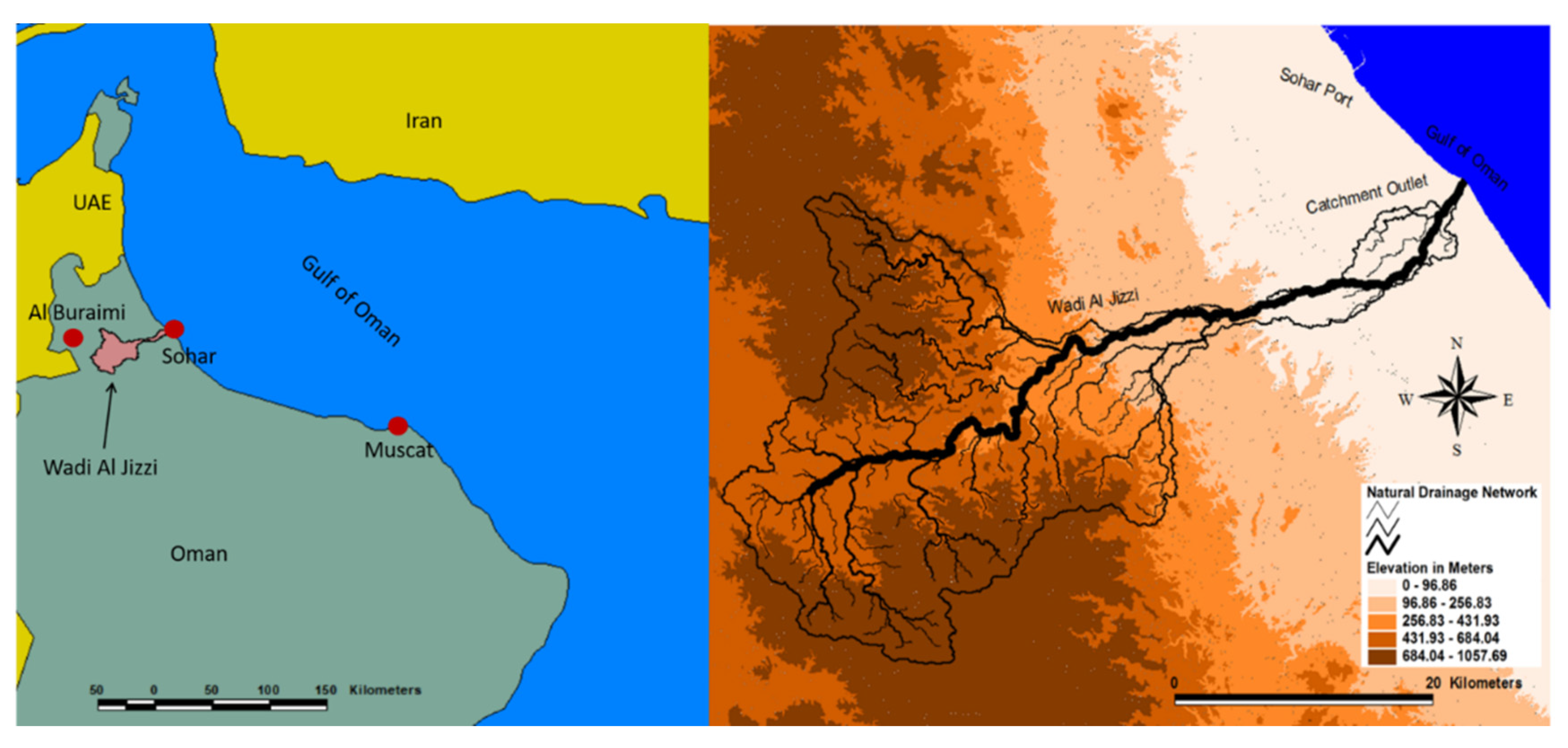
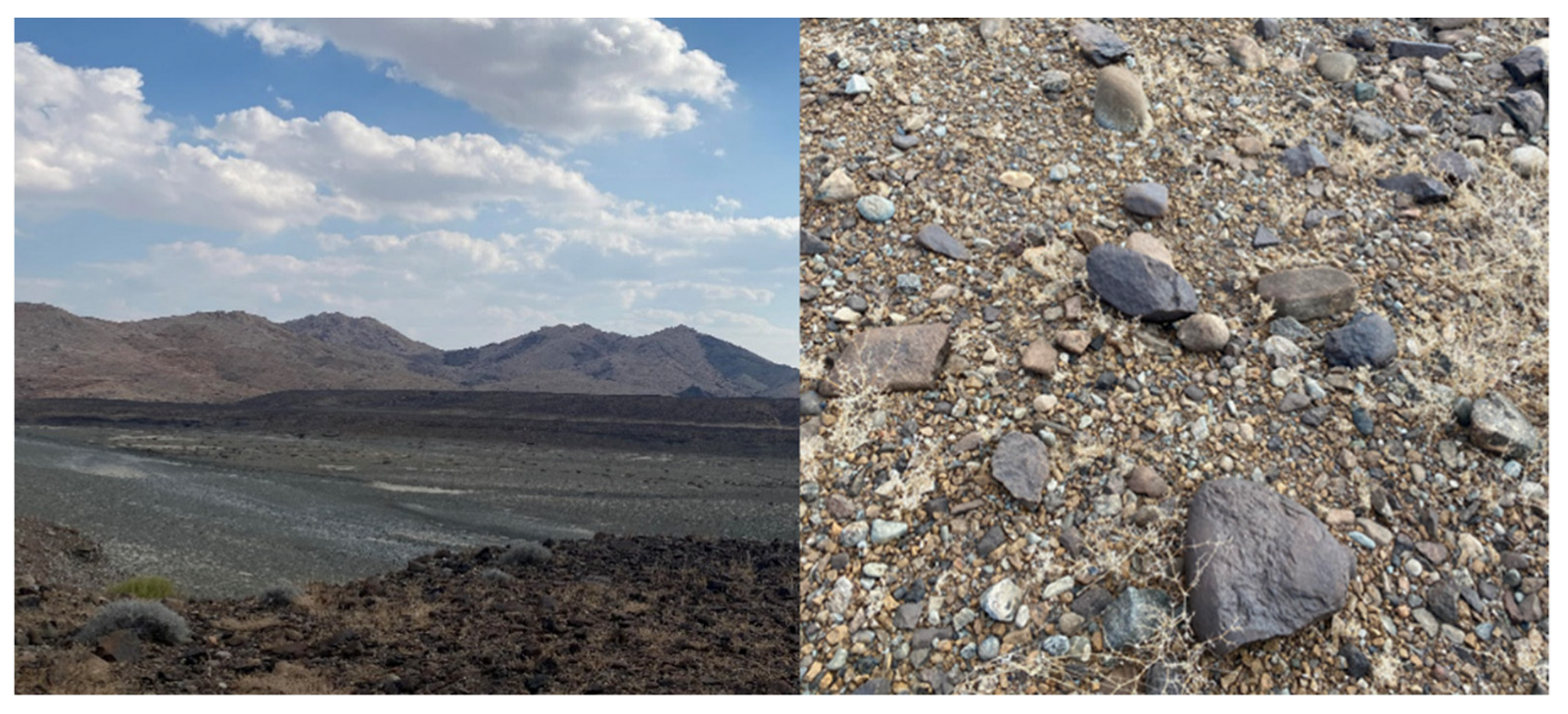
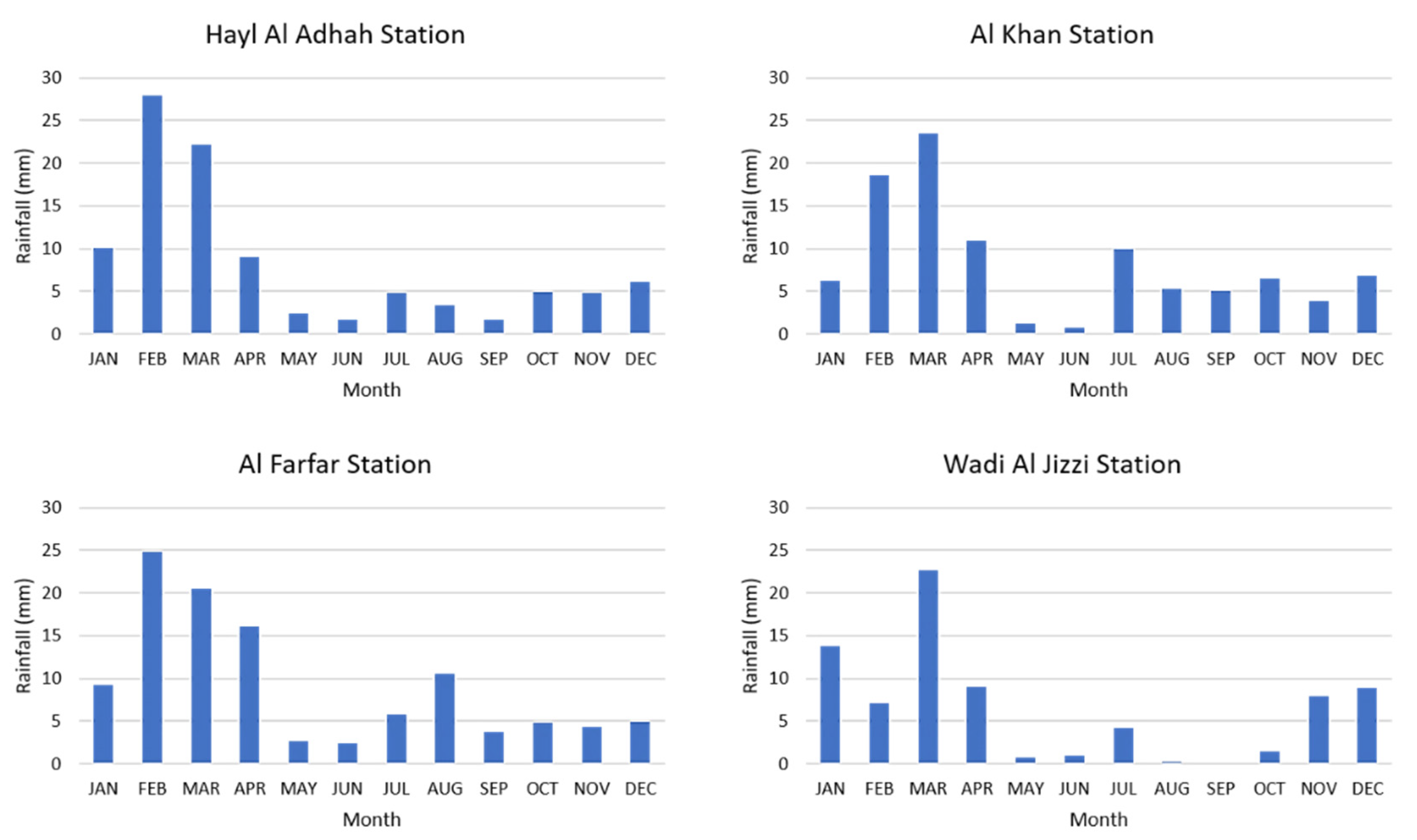
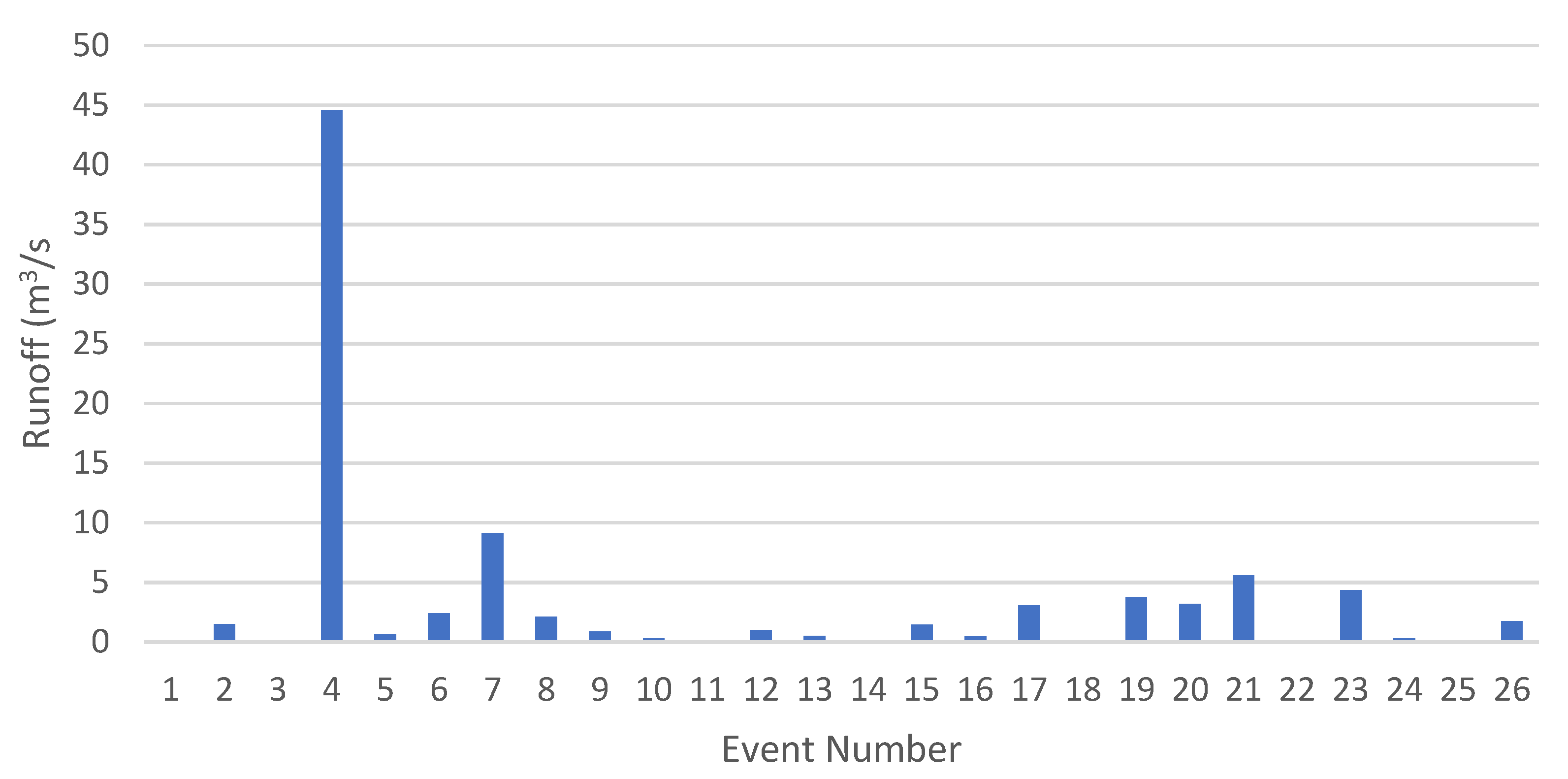
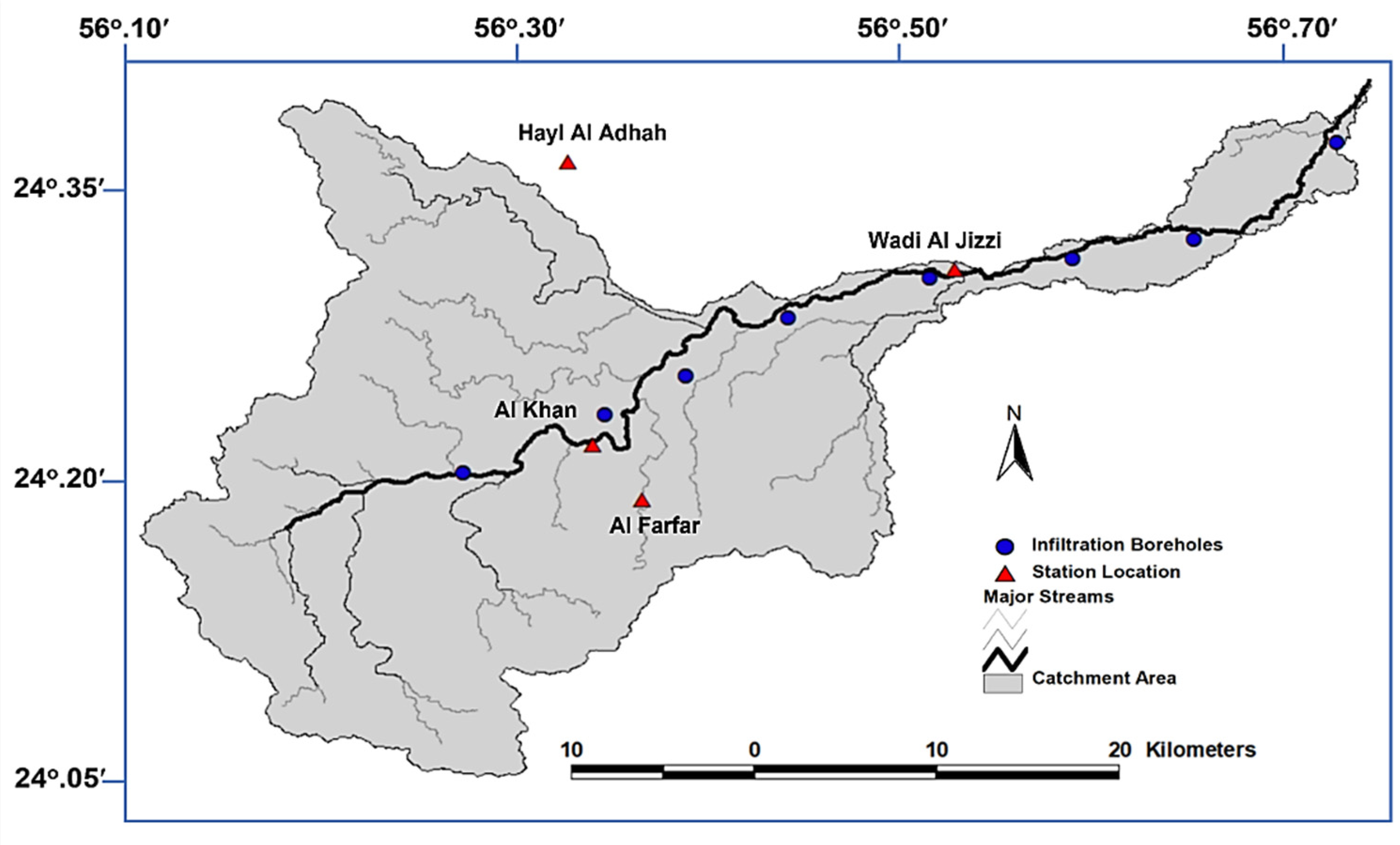


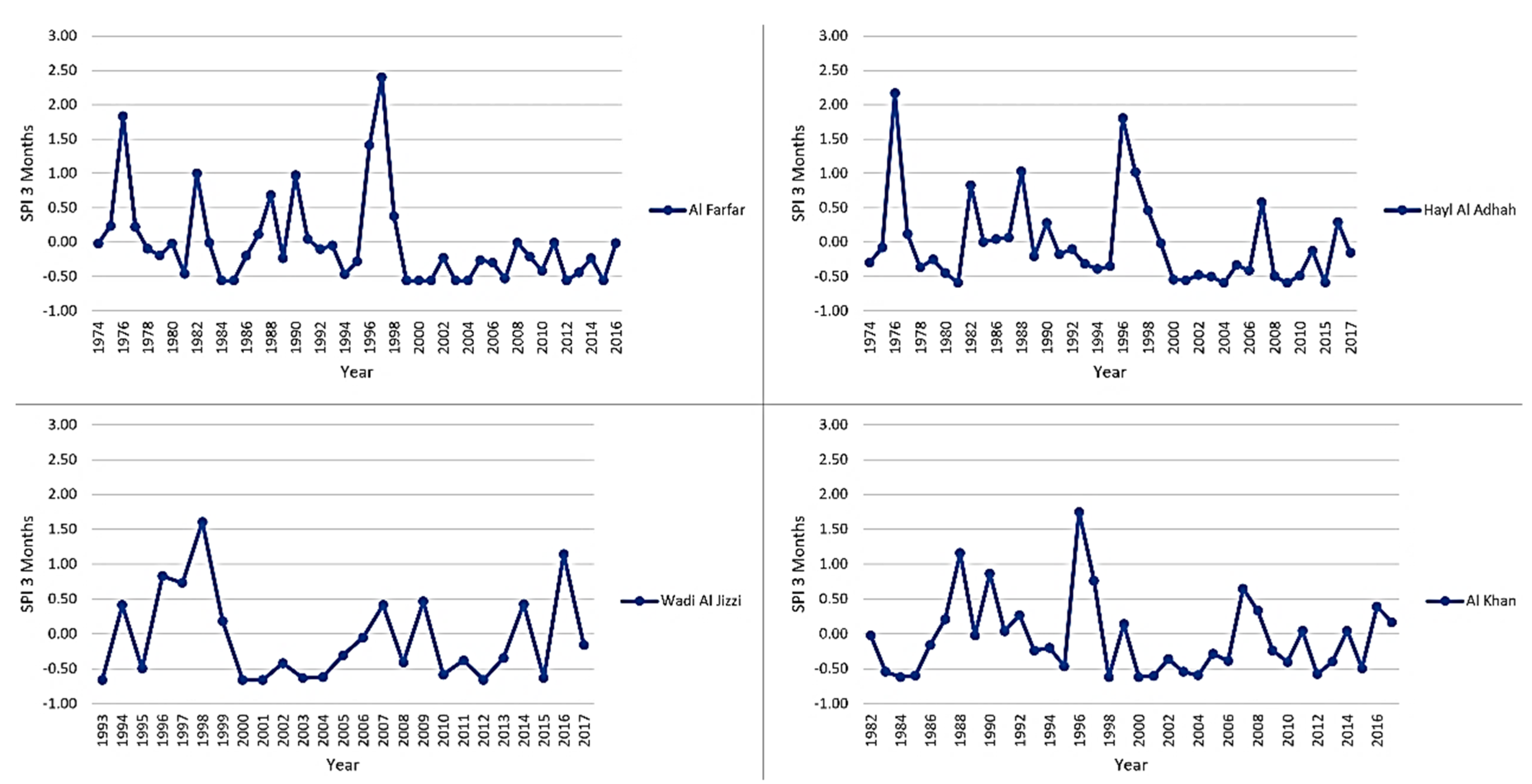
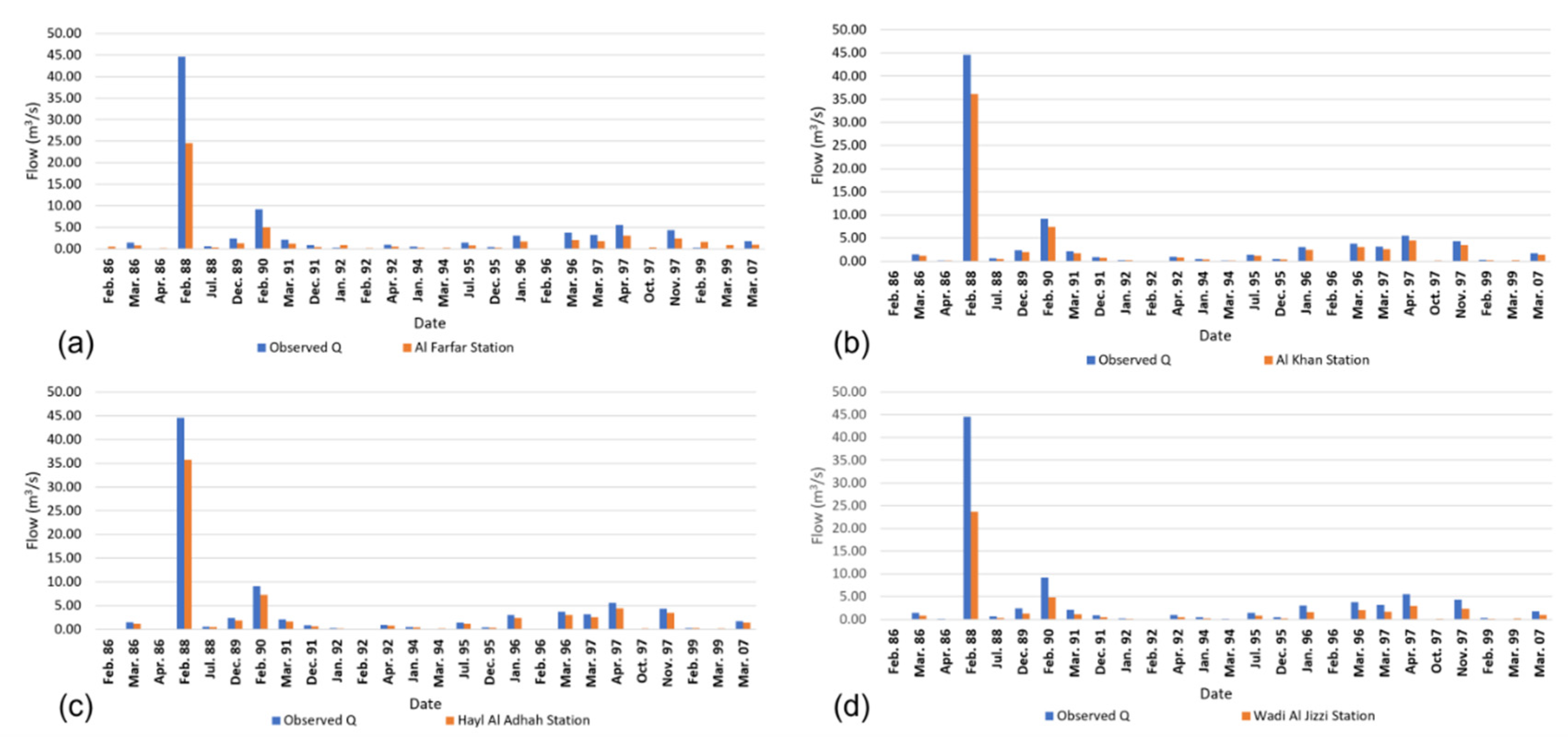
| Elevation Above Sea Level (m) | Annual Rainfall | Acquisition Period | Station Name |
|---|---|---|---|
| 524 | 99.0 | 1947–2017 | Hayl Al Adhah |
| 364 | 98.4 | 1982–2017 | Al Khan |
| 534 | 110.0 | 1974–2016 | Al Farfar |
| 459 | 98.6 | 1993–2017 | Al Jizzi (Near the Dam) |
| SPI Value | Category |
|---|---|
| SPI ≥ 2.00 | Extremely wet |
| 1.50 ≤ SPI ≤ 1.99 | Severely wet |
| 1.00 ≤ SPI ≤ 1.49 | Moderately wet |
| −0.99 ≤ SPI ≤ 0.99 | Near normal |
| −1.49 ≤ SPI ≤ −1.00 | Moderately dry |
| −1.99 ≤ SPI ≤ −1.50 | Severely dry |
| SPI ≤ −2.00 | Extremely dry |
| Criterion | Classifications of RAI Intensity |
|---|---|
| Above 4 | Extremely wet |
| 2 to 4 | Very wet |
| 0 to 2 | Wet |
| −2 to 0 | Dry |
| −2 to −4 | Very dry |
| Below −4 | Extremely dry |
| Station Name | SPI Boundary | January | February | March | April | May | June |
| Hayl Al Adhah | Maximum | 4.55 | 4.32 | 2.83 | 3.18 | 5.46 | 5.22 |
| Minimum | −0.59 | −0.55 | −0.65 | −0.65 | −0.29 | −0.29 | |
| Al Khan | Maximum | 4.51 | 4.51 | 2.82 | 4.19 | 2.77 | 5.27 |
| Minimum | −0.44 | −0.35 | −0.57 | −0.45 | −0.58 | −0.36 | |
| Al Farfar | Maximum | 4.99 | 3.14 | 4.11 | 3.12 | 5.11 | 5.08 |
| Minimum | −0.52 | −0.60 | −0.57 | −0.66 | −0.31 | −0.39 | |
| Al Jizzi (Near the Dam) | Maximum | 4.55 | 4.32 | 2.83 | 3.18 | 5.46 | 5.22 |
| Minimum | −0.59 | −0.55 | −0.65 | −0.65 | −0.29 | −0.29 | |
| Station Name | SPI Boundary | July | August | September | October | November | December |
| Hayl Al Adhah | Maximum | 4.81 | 4.95 | 4.29 | 4.05 | 2.92 | 4.32 |
| Minimum | −0.33 | −0.39 | −0.38 | −0.51 | −0.49 | −0.38 | |
| Al Khan | Maximum | 3.81 | 4.81 | 3.33 | 2.79 | 4.93 | 3.84 |
| Minimum | −0.47 | −0.30 | −0.58 | −0.87 | −0.41 | −0.58 | |
| Al Farfar | Maximum | 5.85 | 4.04 | 3.96 | 3.33 | 5.15 | 4.87 |
| Minimum | −0.29 | −0.47 | −0.41 | −0.46 | −0.35 | −0.33 | |
| Al Jizzi (Near the Dam) | Maximum | 4.81 | 4.95 | 4.29 | 4.05 | 2.92 | 4.32 |
| Minimum | −0.33 | −0.39 | −0.38 | −0.51 | −0.49 | −0.38 |
| Location ID | IR (mm/h) | Soil Type |
|---|---|---|
| A1 | 176.69 | Sand |
| A2 | 59.48 | Loamy sand |
| A3 | 157.50 | Sand |
| A4 | 244.29 | Sand |
| A5 | 124.68 | Loamy sand |
| A6 | 379.49 | Sand |
| A7 | 123.54 | Loamy sand |
| A8 | 157.70 | Sand |
| Simulated Runoff Using SCS | Observed Runoff at Sallan Station |
|---|---|
| Hayl Al Adhah | 0.80 |
| Al Khan | 0.81 |
| Al Farfar | 0.59 |
| Wadi Al Jizzi | 0.56 |
Publisher’s Note: MDPI stays neutral with regard to jurisdictional claims in published maps and institutional affiliations. |
© 2022 by the authors. Licensee MDPI, Basel, Switzerland. This article is an open access article distributed under the terms and conditions of the Creative Commons Attribution (CC BY) license (https://creativecommons.org/licenses/by/4.0/).
Share and Cite
Abushandi, E.; Al Ajmi, M. Assessment of Hydrological Extremes for Arid Catchments: A Case Study in Wadi Al Jizzi, North-West Oman. Sustainability 2022, 14, 14028. https://doi.org/10.3390/su142114028
Abushandi E, Al Ajmi M. Assessment of Hydrological Extremes for Arid Catchments: A Case Study in Wadi Al Jizzi, North-West Oman. Sustainability. 2022; 14(21):14028. https://doi.org/10.3390/su142114028
Chicago/Turabian StyleAbushandi, Eyad, and Manar Al Ajmi. 2022. "Assessment of Hydrological Extremes for Arid Catchments: A Case Study in Wadi Al Jizzi, North-West Oman" Sustainability 14, no. 21: 14028. https://doi.org/10.3390/su142114028
APA StyleAbushandi, E., & Al Ajmi, M. (2022). Assessment of Hydrological Extremes for Arid Catchments: A Case Study in Wadi Al Jizzi, North-West Oman. Sustainability, 14(21), 14028. https://doi.org/10.3390/su142114028







